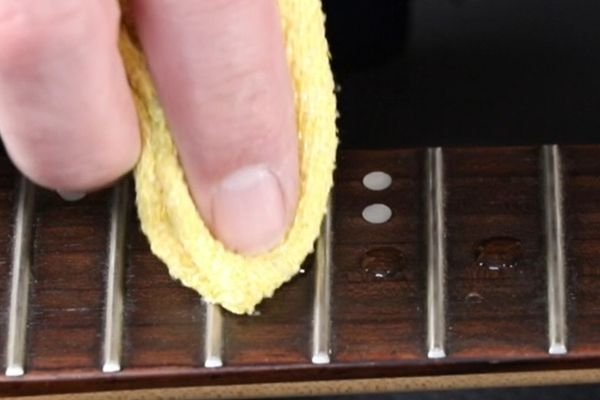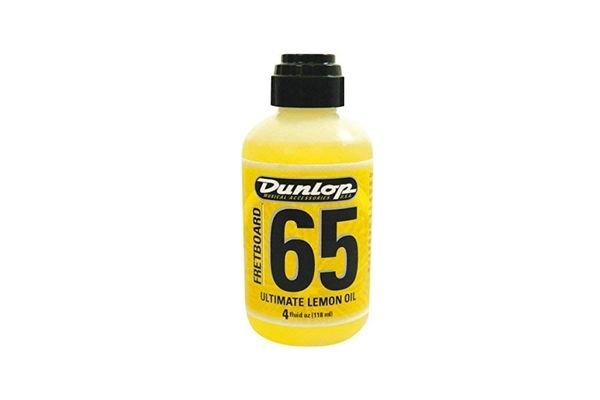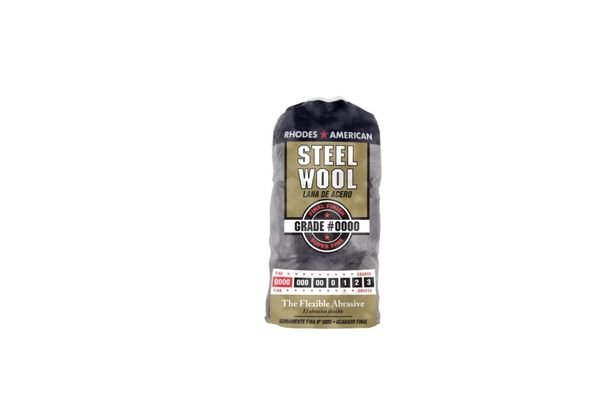Guitars are susceptible to catch dirt whether we play them in practice sessions, studios, or on stages. So, it’s important to clean it, otherwise, it won’t produce the sound we expect. Since the fretboard is the most sensitive part, we must care a bit more.
What happens it, the fretboard catches a lot of oil and sweat from our skin leaving, it dirty and greasy. This gunk on the guitar’s fretboard affects its usability and playability. That’s why knowing how to clean a guitar fretboard is essential to take care of the guitar.
Related Post: How To Clean A Guitar Case The Best Way
Cleaning a guitar fretboard isn’t so complicated, but it’s tricky. So, we need to keep a keen eye on some details. Also, we should know what we can use on a fretboard and what we can’t. In this guide, I’ll provide you with all the details you need to know on how to clean a guitar fretboard easily.
- What To Use To Clean Guitar Fretboard?
- What Not To Use Clean Guitar Fretboard?
- How To Clean A Guitar Fretboard: 10 Easy Steps
- Step-1: Remove The Strings:
- Step-2. Use A Plastic Scrapper To Scrap The Frets:
- Step-3: Blow Off The Scrapped Remains:
- Step-4: Cover The Metal Components:
- Step-5: Use #0000 Steel Wool:
- Step-6: Blow off With A Vacuum Cleaner:
- Step-7: Remove The Tapes:
- Step-8: Apply A Fretboard-safe Oil:
- Step-9: Clean Up The Excess Oil:
- Step-10: Apply Fretboard-safe Oil Again (If necessary):
- How To Clean A Guitar Fretboard With Household Item?
- How To Clean Maple Fretboard?
- How To Clean Rosewood Fretboard?
- How To Clean An Acoustic Guitar Fretboard?
- How To Polish Guitar Frets?
- How To Clean The Neck of A Guitar?
- How To Clean A Guitar Fretboard: Conclusion
- Frequently Asked Questions
What To Use To Clean Guitar Fretboard?
The first thing to do before cleaning a guitar’s fretboard is to check the manufacturer’s instructions so that you get an idea about which items would be suitable for the guitar. There is a good chance that they will suggest an expensive oil or polish, and that’s where I’m going to help you. I will show you how you can make use of household items to clean the fretboard.
Water
With water, we get the advantage of using a chemical-free natural cleaner that won’t damage the fretboard, and of course it’s free too! Obviously, you will not soak the guitar in water. Always use water sparingly, and avoid putting it directly on the fretboard. But the problem is water can be used just for light cleaning. If the fretboard is really greasy, only using water won’t be sufficient.
Distilled Vinegar:
Vinegar can replace water for deep cleaning. Note that, only and only distilled vinegar type is usable on the fretboard; that’s also in a very small amount. Never ever use full-strength vinegar for cleaning fretboards. Moreover, ensure it’s not poured directly onto the frets.
Lemon Oil:
The use of lemon oil on unfinished fretboards is perfectly safe. Lemon oil can clean the fretboard as well as restore its natural oils. Since rosewood or ebony fretboards are often unfinished, oiling and cleaning them with lemon oil would be useful. But what about finished fretboards? Well, we don’t need to oil on finished fretboards.
Vegetable Oil Soap:
Vegetable oil! Yes, it is. Vegetable oil can be good for fretboard cleaning. Put all the confusion away; we aren’t talking about vegetable oil. We are talking about vegetable oil soap, which consists of coconut oil, natural cleaning ingredients, and so few synthetic ingredients. With 98% natural ingredients and pure vegetable oil, it is safe for use on almost any type of wood. I tried it on several guitars, and the result was stunning.
What Not To Use Clean Guitar Fretboard?
Some household items can come in handy in cleaning a fretboard, but that doesn’t mean we can use household cleaning items to clean the fretboard. You should never use the following household items on your fretboard:
Olive Oil:
Olive oil may seem to work fine on a fretboard, but never go for it. Initially, it makes the fretboard smooth, but after a while, it will be sticky, making it uncomfortable to play. Moreover, it will go bad over time, leaving the frets with a strange smell and possibly damaging them. So, I suggest using lemon oil instead of olive oil for cleaning the fretboard.
Bleach:
When it comes to cleaning fretboards, bleach is never a good choice. Although it may remove dirt, it will also remove color and damage the upper layer of wood.
Acetone:
Acetone is excellent for cleaning greasy residue from the guitar’s body, but its harsh nature will damage the frets. For a really sticky situation, you can try a drop of distilled acetone with water, but I won’t recommend that.
Sandpaper:
We all know sandpaper is designed to polish rough wood. So, undoubtedly using it on the fretboard will damage the wood. Therefore, I never recommend using it. You can easily use #0000 steel wool instead of sandpaper on the fretboard.
Isopropyl Alcohol/Ammonia:
Keep this thing installed in mind, always avoid using household cleaners on fretboards that contain ammonia or isopropyl alcohol. The majority of them have an abrasive ingredient that is meant to remove dirt and grime. So, using any of it will surely damage the guitar finishes. There are a lot of household items like vegetable oil soap, lemon oil to use instead of these harmful cleaners.
How To Clean A Guitar Fretboard: 10 Easy Steps
As a guitar’s fretboard is the trickiest part to clean, if we don’t do it properly and the guitar remains unclean, it may affect the sound quality or leave a scratch. Don’t worry, I will be your savior here. Below find a step-by-step guide on how to clean a guitar fretboard that you should follow while cleaning a fretboard.
Step-1: Remove The Strings:
First things first, remove all the strings from the fretboard. One way to avoid the hassle is to clean the fretboard when you change the string sets. However, if the strings are fine but the fretboard needs a cleanup, then remove the strings carefully so that none of the strings gets damaged or bent.

Step-2. Use A Plastic Scrapper To Scrap The Frets:
Scrapping the fretboard is an effective step to follow before using any product on it. To do this properly,
- Take an old plastic card like a credit card, or you can use your guitar pick also.
- Use the long edge of the card to scrap between each fret and gently push the card inside the frets horizontally.
- If the dirt is too close to the fret, use the corner of the card or the top of the pick to remove those.
Caution:
- Be very careful and keep the pressure light while following this step, otherwise there can be dents on the wood.
- Never use a knife or something so sharp to scrap.
Step-3: Blow Off The Scrapped Remains:
Scrapping the frets will leave scrapped particles scattered everywhere. If you’re cleaning the fretboard inside, using a vacuum cleaner to remove those scrapped particles would be easy. Conversely, simply blow or brush the particles off if you’re cleaning outside.
Caution: Be very careful with the vacuum bristles. On the fretboard, they’re ok, but while dragging them over the guitar’s body, do it with extra caution, as they can damage the guitar’s glossy finish.
Step-4: Cover The Metal Components:
Covering the metal components is a must, especially when cleaning electric guitars, as the pickups are magnetic. I recommend using low-tack masking tape to cover all the metal components. Removing the tapes will be pretty easy with the use of it.
Step-5: Use #0000 Steel Wool:
#0000 steel wool is a fine grade that won’t leave any scratches on the wood. To use it properly, take a piece of steel wool between a small and medium size. Then rub it on the fretboard with medium pressure and remove any remaining oil or dirt from the wood.
Caution: Don’t put pressure on the fretboard while using the steel wool, and always remember to go with the wood grain, not the opposite.
Step-6: Blow off With A Vacuum Cleaner:
Once you have used steel wool and you are certain that all dirt and oil have been thoroughly removed, clean up the whole guitar again. This time, I recommend using a vacuum cleaner to clean up the remaining.
Caution: Be very careful while using the vacuum cleaner on the body of the guitar, and don’t let even so little steel wool remaining to be on the pickups or the sound hole of the guitar.
Step-7: Remove The Tapes:
Take time in this step, and remove all the tape slowly and carefully. Be particularly cautious if you used regular masking tape rather than the low-tack tape or if yours is an old guitar with a vintage finish. And then, make one final check for any steel wool remaining after all the tapes have been removed.
Step-8: Apply A Fretboard-safe Oil:
While scrapping or using steel wool, the wood color may fade, or it can lose a little moisture, using a fretboard-safe oil brings back that rich color. So, I always use a fretboard-safe oil and find it really effective. Now, here is the process,
- Take 1-2 drops of a fretboard-safe oil you like in a soft cotton cloth. I really like product name for oiling the fretboard.
- Rub the cloth on the fretboard in any particular direction and cover one fret before moving on to the next.
- Keep applying 1-2 drops of oil into every fret, and if the cloth becomes dry, apply 1-2 more drops of oil to it.
Note: Don’t wipe off the oil just after rubbing it, keep it for a minute.

Step-9: Clean Up The Excess Oil:
After oiling every fret, start rubbing off the excess oil from the first fret. Again, put light pressure while doing it, and make sure to rub in the same direction as the wood grain.

Step-10: Apply Fretboard-safe Oil Again (If necessary):
For this step, you need to make the judgment whether it’s necessary or not. If you think the fretboard needs another coating, give it a try. Usually, one application will last for so long.
How To Clean A Guitar Fretboard With Household Item?
Several cleaning ways with household items can save us from purchasing any product to clean the guitar fretboard. In this section, I’ve shown four easy but effective methods that you can easily understand how to clean a guitar fretboard with household items.
Water:
Follow these three steps to wash a fretboard with water;
Step 1 take a microfiber cloth and dampen it with a little water.
Step 2 start cleaning the fretboard with the cloth fret by fret.
Step 3 use a dry cloth and wipe it down, so there is no moisture left.
Distilled Vinegar:
Here are the three steps to cleaning a fretboard with distilled vinegar;
Step 1 Take a microfiber cloth and dampen it with a little bit of distilled vinegar.
Step 2 Start cleaning the fretboard with the cloth fret by fret.
Step 3 Using a dry cloth, wipe it down.
Lemon Oil:
You can clean the fretboard with lemon oil by following these three steps;
Step 1 Take a microfiber cloth and dampen it with one or two drops of lemon oil.
Step 2 Start cleaning the fretboard with the cloth fret by fret.
Step 3 Use a dry cloth and wipe down the fretboard.
Vegetable Oil Soap:
Using vegetable oil soap, clean fretboards as follows;
Step 1 Take a microfiber cloth and dab a little vegetable oil soap on it.
Step 2 Take the cotton ball or microfiber cloth and rub it gently for a couple of minutes on the fretboard.
Step 3 Soak a soft cloth in water and wipe out the oil properly.
Step 4 After wiping the fretboard with the wet cloth, use a dry cloth on it right away to prevent moisture from accumulating.
How To Clean Maple Fretboard?
Ultra-fine 0000 steel wool is one of the best cleaning options for unfinished Maple fretboards. This eliminates dirt without damaging the frets. For the cleaning procedure,
- Take a piece of steel wool between a small and medium size.
- Rub it on the fretboard with medium pressure and remove any remaining oil or dirt from the wood.
On the other hand, cleaning a finished Maple fretboard is pretty easy. Just use a dry cloth or slightly dampen it with water. To conduct the cleaning process,
- Take a soft and clean dry cloth, or soak it into a bit of water.
- Clean each fret one at a time with the cloth.
- Wipe the fretboard down with a dry cloth to remove any remaining moisture.
Our Detailed Review: How To Clean Maple Fretboard

How To Clean Rosewood Fretboard?
Applying Lemon Oil can be effective in cleaning Rosewood fretboards. Just take a piece of cotton and moisten it with one or two drops of oil, and then use the cotton to clean the fretboard. But if the fretboard has excessive dirt, then it needs to be removed before applying the oil. For the cleaning procedure,
- Take 1-2 drops of a fretboard-safe oil you like in a soft cotton cloth.
- Rub the cloth on the fretboard in any particular direction and cover one fret before moving on to the next.
- Keep applying 1-2 drops of oil into every fret, and if the cloth becomes dry, apply 1-2 more drops of oil to it.

How To Clean An Acoustic Guitar Fretboard?
If you learn how to clean a guitar fretboard properly, then cleaning an acoustic guitar fretboard would be nearly the same as cleaning an electric guitar fretboard to you. There isn’t much difference between cleaning the fretboard of an acoustic guitar and an electric guitar. As an acoustic guitar is usually made of Rosewood rather than Maple, using lemon oil would be sufficient enough not only for cleaning but also for hydrating the fretboard. So, for cleaning,
- Take a clean and soft cloth and dampen it with one or two drops of lemon oil.
- Wrap the cloth around your index finger and clean the fretboard using your index finger fret by fret
- Use a dry cloth and wipe down the fretboard.
Note: When using Lemon Oil, ensure to use very little because you don’t want to over-saturate the guitar. Generally, two drops will be enough for 4-5 frets.
How To Polish Guitar Frets?
Before polishing the guitar frets, you must remove the strings and clean any kind of dirt or grease from the fretboard. Now, to polish the guitar frets,
- Use a fret polish for the process. I recommend using MusicNomad FRINE Fret Polish, which provides an amazing finish.
- Use a clean and soft cloth and rub the polish on the frets gently. Don’t need to put too much pressure; just keep rubbing frets one by one.
- Wipe the fretboard with a soft and clean cloth, and put the strings back on.
How To Clean The Neck of A Guitar?
Guitar’s neck is the area that becomes sticky the quickest. So, keeping it clean is really important to have a pleasant feeling while playing the guitar. Follow the below steps to clean the neck of a guitar properly;
Step 1 Take naphtha or any other non-wax cleaner and rub the guitar neck properly with it.
Step 2 Take a tape and use it to cover the headstock.
Step 3 Use a soft and clean cloth, put a few drops of water on it, and use the cloth to rub the neck.
Step 4 Remove the tape after the neck has dried.
How To Clean A Guitar Fretboard: Conclusion
Keeping the fretboard clean means the guitar will be in good condition, sounding at its best, and fun to play. So, there is no way you can avoid and maintain the guitar at its best shape. It’s true that cleaning process may take some times and lot of us don’t know how to clean a guitar fretboard properly. Hope this easy-to-follow step-by-step guide on how to clean a guitar fretboard help you all the way.
Frequently Asked Questions
Can I use coconut oil for guitar fretboard?
No. coconut oil cannot be used on fretboards directly as it can harden the fretboard. Using coconut oil can result in damage to the fretboard.
Can I use water for cleaning guitar fretboard?
Yes. You can use water only for light cleaning and only a small portion can be used. If the fretboard is too greasy, using water may not work.
Can I clean guitar fretboard without oil?
It depends on your fretboard. If the fretboard is finished type, then you don’t need to oil it. In contrast, if it is an unfinished type, you need to oil it, lemon oil can be used for better results.
Can I clean guitar fretboard with strings on?
If you just use a dry cloth, then it won’t be an issue to keep the strings on. But if you clean the fretboard properly, like using steel wool or lemon oil, then always remove the strings at first, otherwise, strings can be damaged easily.



